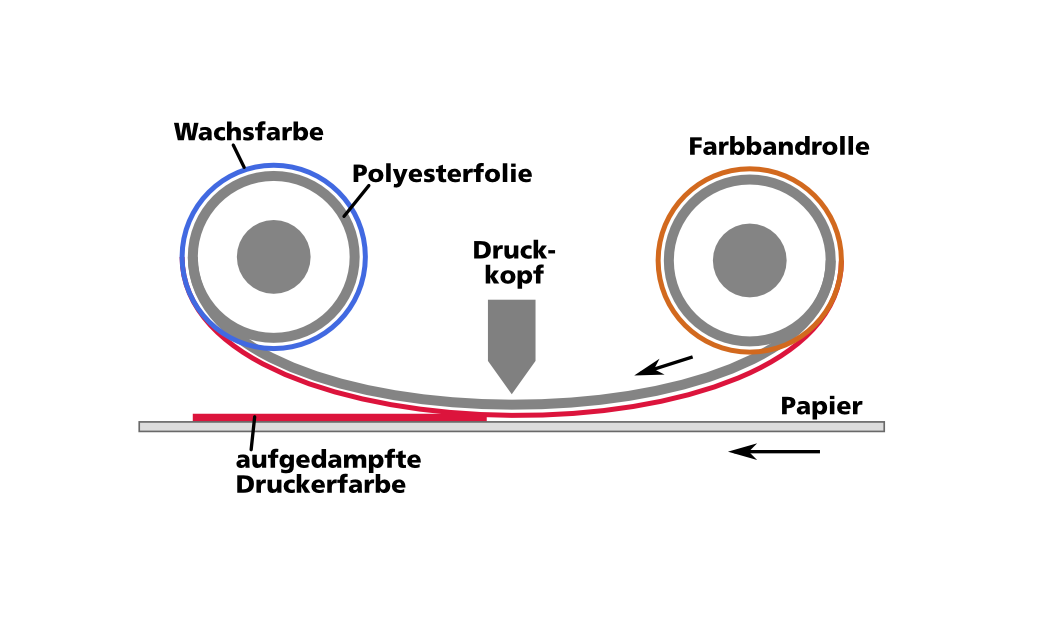
The printer has a thermal ridge, which contains the thermal print head. This consists of an array of small heaters. In addition a moving coil with a ribbon and a second polyester film with a color guard and a wax color synchronously moving with the paper.
When printing with a thermal unit, the thermal ridge is moved past the paper. By heat dissipation of the heating elements, a small thermal time unit is reached, so you can print the paper in a continuous motion, this happens with very high resolution.
We distinguish between three different printing technologies:
One of the first major advantage is its high resolution, which is reached during the printing process and a variety of pressure contrasts are also ensured. Color printing is also possible, the printerhead and the ribbon are protected from contact with the to-be printed paper.? one can expect high reliability when printing, because the thermal printer only has a small amount of mechanical components. ?In addition, digital prints are feasible, without the use of plates.
Unfortunately, there are also disadvantages, such as the high cost of printing, that is caused by the use of color film and the release of ink from the paper when mechanically stressed i.e. placed under sunlight or stored in a warm environment. This mechanical stress causes the print to fade over time.
The thermal printing is used for warnings, as well as labels for textiles. ? ? this printing method is also used to annotate signs of many, due to its long shelf life guarantee. Furthermore devices are also characterized by this technique.
The general idea on which the printhead of a thermal printer is build, is essentially the same as for dot-matrix printers: The printhead comprehends one or more arrays of the actual “printing” part. However in contrast to the pins of a impact matrix the thermal head contains hot plates, that can be, as well as the dot-matrix pins, separately controlled. The hot plates release the colour by heating the ribbon or the paper, which all happens while the printhead is moving. This renders a high horizontal resolution possible, when the hot plates are accessed with precise timing. But this technique has also a disadvantage: Through the heating and cooling the marginal sharpness in printing direction as opposite to cross direction is noticeably affected. Moreover the printing quality differs a lot depending on the model, because whereas the resolution in cross direction is mainly determined by the distance between the hotplates within an array, the resolution in printing direction depends on the printhead speed as well as the precise controlling and the physical characteristics of the hot plates. This often results in asymmetric printing resolutions like 300x150dpi.
As mentioned above the pigment may be contained in the paper, which then is called direct thermal printing. This means the printer contains no ribbon and the "thermochromic paper" (or "thermal paper" in short) has a special coating (a matrix), which chemically binds dye, developer etc. When the heated printhead runs over the coated side of the paper the mostly black colour is constituted from it's parts and becomes visible on the paper. But it turns out that the rendering of greys is only realisable by rasterisation, since the heat radiation of the printhead cannot be controlled as precisely as to make a partial dyeing of the paper possible.
Though a printer, that makes use of the principle of thermal ink transfer printing, possesses a ribbon, it's not a ink soaked cloth band, but a special foil with a coating, basically consisting of the same components as thermal paper: pigment, binding agent, developer. The coated side is facing the material to be printed. There is also a backing foil on the back of the ribbon, that is supposed to protect the colour and the paper from the heat emitted by the printhead. It is also called “Back coating”. Like the thermal paper the dye is released from the dye coating as soon as the printhead heats the foil and thus the dye is emitted and applied onto the paper. But this as well implies, that the dye is always completely set free from the ribbon and hence no graduation is possible.
As the “sublimation” in the name of the method implies, this is a vapour deposition process, i.e. the dye on the ribbon transitions to the gas state, when it is heated, and thus directly enters the printing material and there condenses out. Therefore, however, the printer is able to apply just a portion of the dye by controlling the energy feed at a certain printer dot. For that reason it is possible to print up to 64 graduations, which is a good colour precision.
With this printing technique as well as with thermal ink transfer it is possible to print polychrome. But this requires the printer to navigate to the same position typically four times (CMYK), therefore these processes are quite time consuming. Moreover the resulting print image is prone to external influences (sun light, heat) and therefore often has to be covered with a protective coating to ensure a durable life (up to 25 years according to manufacturers).